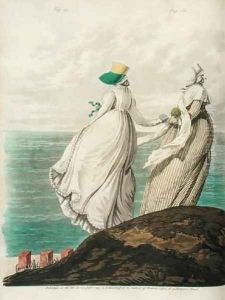Nicolaus von Heideloff Paintings
Nicolaus von Heideloff was a German artist known for his work as an engraver, illustrator, and publisher during the late 18th and early 19th centuries. Born in 1761 in Nuremberg, Germany, a city with a rich tradition in the arts and particularly in printmaking, Heideloff was exposed to a vibrant artistic environment from an early age.
Heideloff's career is marked by his contributions to the world of fashion illustration. He is perhaps best known for his work on 'The Gallery of Fashion,' which was one of the earliest fashion magazines. This publication, which he began in London in 1794, was instrumental in documenting and influencing the style and dress of the period. The magazine showcased detailed and exquisitely colored plates of contemporary fashion, and it became an important reference for the styles of the English Regency and the Directoire and Empire periods in France.
Heideloff's engravings were highly detailed and reflected the opulence and intricacy of late 18th-century and early 19th-century fashion. His work captured the transition from the more elaborate and ornate styles of the late 1700s to the simpler, more classical lines that characterized the clothing of the early 1800s. 'The Gallery of Fashion' ran until 1807, and during its years of publication, it was an essential source for trends in European fashion.
In addition to his work in fashion illustration, Heideloff was involved in various other artistic projects. He was a skilled engraver and his expertise extended into architectural and decorative arts. This versatility allowed him to work on a range of subjects and to collaborate with other artists and patrons of his time.
Nicolaus von Heideloff passed away in 1837, leaving behind a legacy particularly revered by costume historians and enthusiasts of fashion history. His work provides a valuable window into the aesthetics and societal norms of his era, as well as the evolution of fashion publishing. Although Heideloff may not be as widely known as some of his contemporaries, his contributions have had a lasting impact on the fields of fashion illustration and historical costume research.
